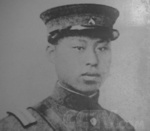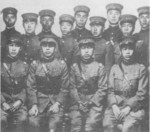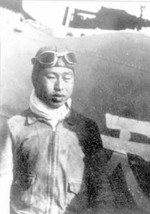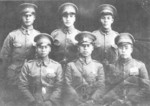Gao Zhihang
| Surname | Gao |
| Given Name | Zhihang |
| Born | 14 May 1907 |
| Died | 28 Nov 1937 |
| Country | China |
| Category | Military-Air |
| Gender | Male |
Contributor: C. Peter Chen
ww2dbaseGao Mingjiu was born in Tonghua, Andong Province, China into a wealthy Roman Catholic family in 1907, during the final years of the Qing Dynasty. He attended the Sino-French High School in Fengtien (now Shenyang) in the neighboring province of Liaoning Province. At this missionary-established school, he learned the basics in the French language. In 1920, he was admitted into the Education Class of the Northeast Army Officers as an artillery cadet. In 1924, he applied to the Aviation School of Northeastern China; his application was initially rejected, but a heart-felt letter changed commandant's mind. He married Shao Wenzhen later in the same year (they did not have any children; Shao would commit suicide in 1927). Along with 27 fellow cadets, he was sent to France for flight training. In France, he spent two years in basic flight instructions, then specialized in fighter tactics, and finally joined French Army 23rd Pursuit Group in Nancy, France for hands-on experience. During his time in France, he renamed himself Gao Zhihang (Wade-Giles romanization: Kao Chih-hang). Returning to China in Jan 1927, he was posted to the Flying Eagle Squadron of warlord Zhang Zuolin's Northeast Army. In 1928, in northern China (in today's Inner Mongolia region), he married his second wife "Ge Li Er", a White Russian émigré whose full name had since been lost to history (they would have two daughters. In 1929, he was made a flight instructor. In 1931, after the Japanese interference in northeastern China that ultimately resulted in the establishment of the Manchukuo puppet state, he left the Northeast Army and joined the air force of the Nationalist central government. It was at this time he was faced with a difficult decision. For security reasons, Republic of China Air Force had a policy that high ranking officers could not marry women of foreign nationalities, thus he had to choose between his career or his wife; he chose the former, divorcing his White Russian wife in 1931. He secretly kept in touch with her for some time, but when this was discovered, she was forcibly deported (the Gao family would be in search of her for decades to come, without success). Due to injuries from an air accident, he did not see combat in the First Battle of Shanghai in 1932. In 1932, he married his third wife Ye Rongran (they would have a son and a daughter). In 1933, he received advanced flight training at the Central Flying School at Jianqiao Airfield near Hangzhou, Zhejiang Province, China, then remaining to become an instructor. He experienced some setbacks in his career growth during this time due to his past service with the Northeast Army, including a demotion from major to captain, but his skills shown during a flight demonstration led to recognition and then the appointment to command the 8th Pursuit Squadron. In the spring of 1934, he was promoted to the rank of colonel and was made the commanding officer of the 4th Pursuit Group with concurrent duty as an instructor at Jianqiao Airfield. In 1935, he was sent to Italy to study the Italian Air Force. During a demonstration flight in Italy, Benito Mussolini supposedly took notice of Gao and attempted to employ him, offering large sums of cash. Failing at this, Mussolini then asked him to help convince China in purchasing Italian aircraft for its air force. Gao again refused. Mussolini admired Gao's unwavering loyalty and gifted Gao his personal sidearm as a memento for his visit to Italy. In 1936, he was stationed in Nanchang, Jiangxi Province, China to head a training command. At the eve of the WW2, he was the Deputy Chief of Instruction with concurrent duty as the commanding officer of the 4th Pursuit Group at Jianqiao Airfield.
ww2dbaseIn the morning of 14 Aug 1937, Gao attended a meeting in Nanjing, China. In the afternoon, as soon as he landed at Jianqiao, he was notified of 18 Japanese G3M1 Model 11 bombers approaching from Matsuyama Airfield in Taihoku (now Taipei) in northern Taiwan. He immediately took flight in a Hawk III fighter without refueling. In the subsequent dogfight, he shot down the Japanese bomber flown by Petty Officer 3rd Class Iyoshio Momosaki over Hangzhou Bay, sending it onto the bank of Qiantang River. He pursued two retreating G3M bombers, but between being low on fuel and being damaged by the bombers defensive gunners, he chose to return to base. The downing of Momosaki's G3m bomber represented the very first aerial victory of the Chinese Air Force in WW2. His pilots shot down an additional 5 bombers without any losses. This successful aerial engagement made Gao a war hero.
ww2dbaseIn the morning on the following day, 15 Aug, Japanese carrier aircraft from Kaga attacked Jianqiao Airfield. The Chinese were caught by surprise, but 21 Hawk III fighters were able to take to the air before the Japanese arrived. Gao shot down one B2M torpedo bomber and damaged another, but during the process a bullet or shrapnel wounded his left arm, forcing him to return to Jianqiao for medical treatment. In his absence, his fellow pilots continued the success, wiping out all but one of the eight-plane B2M force, killing the commanding officer Lieutenant Commander Iwai. Chinese leader Chiang Kaishek awarded him a 10,000 Yuan bonus and ordered him to be transferred to a hospital in Hankou, Hubei Province, China, a safer place for recuperation.
ww2dbaseAfter being released, in Oct 1937, Gao was made the commander of all three fighter groups in the Nanjing area with personal command over the 4th Pursuit Group. Under his initiative, aircraft mechanics stripped the obsolete Hawk III fighters of bomb racks, navigation lights, auxiliary fuel tanks, and fairings in order to improve the rate of climb and top speed in order to deal with the new generation of monoplane fighters that the Japanese were beginning to deploy to China. On 12 Oct, flying one of such stripped down Hawk III fighters, he shot down a Japanese E8N floatplane. In the afternoon, over Nanjing, he shot down an A5M fighter and then managed to escape from the three other A5M fighters that jumped on him.
ww2dbaseIn Nov 1937, newly made the commanding officer of all fighter units of the Chinese Air Force, Gao personally took delivery of some Soviet-made I-16 Type 5 fighters in Lanzhou, Gansu Province. En route back to the east coast of China, he and a number of other 4th Pursuit Group pilots landed at Zhoujiakou Airfield in Henan Province, China to refuel and to wait out a storm. In the morning of 21 Nov 1937, he received urgent intelligence of incoming Japanese G4M2 bombers of the Kisazaru Kokutai. He immediately ordered his men to scramble, but his mechanics had trouble starting the engine of his own I-16 fighter. While waiting in the cockpit, a Japanese bomb struck near the fighter, killing him.
ww2dbaseGao's memorial ceremony was held at Hankou, with Chiang personally presiding and with communist leader Zhou Enlai also in attendance. He was posthumously promoted to the rank of major general. It was initially decided to bury him in the Chinese war time capital of Chongqing, but because of repeated Japanese attacks and the risk of losing his remains en route, he was buried in Yichang, Hubei Province, China. To avoid possible Japanese retribution against Gao's grave, the burial site at the hospital building on Yiling Avenue in Yichang was left unmarked, which led to it becoming lost until 2010. In Sep 1939, the Nationalist government made 14 Aug the Air Force Day holiday in commemoration of Gao's first victory.
ww2dbaseSources:
Raymond Cheung, Aces of the Republic of China Air Force
Wikipedia
Last Major Revision: Jan 2015
Gao Zhihang Interactive Map
Photographs
 |  |  |  |
Gao Zhihang Timeline
| 14 May 1907 | Gao Mingjiu was born in Tonghua County, Liaoning Province, Qing Dynasty China. |
| 14 Aug 1937 | 18 Type 96 G3M bombers of the Japanese Kanoya Air Group took off from the Matsuyama Airfield in Taihoku (now Songshan Airport in Taipei), Taiwan to bomb Jianqiao Airfield at Hangzhou in Zhejiang Province and Guangde Airfield in Anhui Province in China. Fighters of the Chinese 4th Pursuit Group, led by Captain Gao Zhihang, rose to intercept from Jianqiao and shot down 3 bombers without any losses. Cheng Xiaoyu's 22nd Squadron, also of the Chinese 4th Pursuit Group, rose to meet the other group attacking Guangde Airfield, shooting down another. Anti-aircraft crews claimed a further two bombers destroyed. Gao's downing was the first Republic of China Air Force victory of WW2. In 1939, the Chinese Nationalist government would declare 14 Aug as a holiday, Air Force Day, as an instrument to raise morale. |
| 12 Oct 1937 | Gao Zhihang, flying a stripped down Hawk III fighter, he shot down a Japanese E8N floatplane in the morning and an A5M fighter over Nanjing, China. Three other A5M fighters counterattacked him, but Gao was able to evade, with his returning fire fatally wounding the pilot of one of the three A5M fighters. The pilot would be able to land his aircraft before dying. Gao was denied the score of the third victory of the day as the captured A5M was secretly sent to the Soviet Union for study in a deal struck between Nanjing and Moscow. |
| 21 Nov 1937 | Gao Zhihang, while at Zhoujiakou Airfield in Henan Province, China, awaiting his mechanics to start the engine of his I-16 fighter during a Japanese raid conducted by G4M2 bombers, a bomb struck near his aircraft, killing him. |
| 28 Nov 1937 | Gao Zhihang's remains reached Yichang, Hubei Province, China. |
Did you enjoy this article or find this article helpful? If so, please consider supporting us on Patreon. Even $1 per month will go a long way! Thank you. Share this article with your friends: Stay updated with WW2DB: |
» Second Battle of Shanghai
» Bombing of Shanghai, Chongqing, and other Cities
Related Books:
» Aces of the Republic of China Air Force
- » 1,150 biographies
- » 337 events
- » 43,917 timeline entries
- » 1,241 ships
- » 350 aircraft models
- » 207 vehicle models
- » 374 weapon models
- » 123 historical documents
- » 260 facilities
- » 470 book reviews
- » 28,540 photos
- » 432 maps
Winston Churchill
Please consider supporting us on Patreon. Even $1 a month will go a long way. Thank you!
Or, please support us by purchasing some WW2DB merchandise at TeeSpring, Thank you!